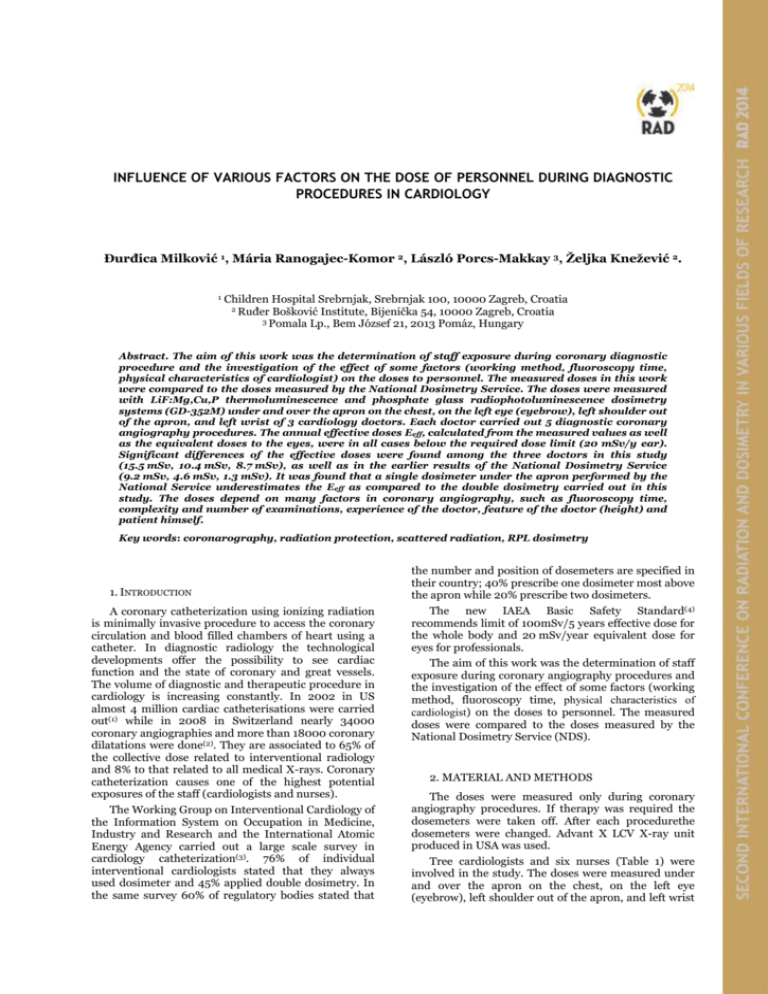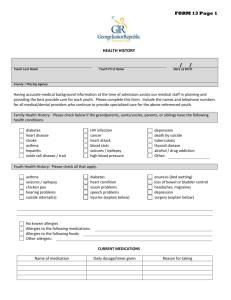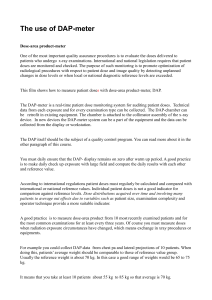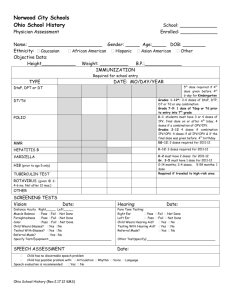740602.Paper-Milkovic-Template_RAD2014_revised
advertisement

INFLUENCE OF VARIOUS FACTORS ON THE DOSE OF PERSONNEL DURING DIAGNOSTIC PROCEDURES IN CARDIOLOGY Đurđica Milković 1, Mária Ranogajec-Komor 2, László Porcs-Makkay 3, Željka Knežević 2. 1 Children Hospital Srebrnjak, Srebrnjak 100, 10000 Zagreb, Croatia 2 Ruđer Bošković Institute, Bijenička 54, 10000 Zagreb, Croatia 3 Pomala Lp., Bem József 21, 2013 Pomáz, Hungary Abstract. The aim of this work was the determination of staff exposure during coronary diagnostic procedure and the investigation of the effect of some factors (working method, fluoroscopy time, physical characteristics of cardiologist) on the doses to personnel. The measured doses in this work were compared to the doses measured by the National Dosimetry Service. The doses were measured with LiF:Mg,Cu,P thermoluminescence and phosphate glass radiophotoluminescence dosimetry systems (GD-352M) under and over the apron on the chest, on the left eye (eyebrow), left shoulder out of the apron, and left wrist of 3 cardiology doctors. Each doctor carried out 5 diagnostic coronary angiography procedures. The annual effective doses Eeff, calculated from the measured values as well as the equivalent doses to the eyes, were in all cases below the required dose limit (20 mSv/y ear). Significant differences of the effective doses were found among the three doctors in this study (15.5 mSv, 10.4 mSv, 8.7 mSv), as well as in the earlier results of the National Dosimetry Service (9.2 mSv, 4.6 mSv, 1.3 mSv). It was found that a single dosimeter under the apron performed by the National Service underestimates the Eeff as compared to the double dosimetry carried out in this study. The doses depend on many factors in coronary angiography, such as fluoroscopy time, complexity and number of examinations, experience of the doctor, feature of the doctor (height) and patient himself. Key words: coronarography, radiation protection, scattered radiation, RPL dosimetry 1. INTRODUCTION A coronary catheterization using ionizing radiation is minimally invasive procedure to access the coronary circulation and blood filled chambers of heart using a catheter. In diagnostic radiology the technological developments offer the possibility to see cardiac function and the state of coronary and great vessels. The volume of diagnostic and therapeutic procedure in cardiology is increasing constantly. In 2002 in US almost 4 million cardiac catheterisations were carried out(1) while in 2008 in Switzerland nearly 34000 coronary angiographies and more than 18000 coronary dilatations were done(2). They are associated to 65% of the collective dose related to interventional radiology and 8% to that related to all medical X-rays. Coronary catheterization causes one of the highest potential exposures of the staff (cardiologists and nurses). The Working Group on Interventional Cardiology of the Information System on Occupation in Medicine, Industry and Research and the International Atomic Energy Agency carried out a large scale survey in cardiology catheterization(3). 76% of individual interventional cardiologists stated that they always used dosimeter and 45% applied double dosimetry. In the same survey 60% of regulatory bodies stated that the number and position of dosemeters are specified in their country; 40% prescribe one dosimeter most above the apron while 20% prescribe two dosimeters. The new IAEA Basic Safety Standard(4) recommends limit of 100mSv/5 years effective dose for the whole body and 20 mSv/year equivalent dose for eyes for professionals. The aim of this work was the determination of staff exposure during coronary angiography procedures and the investigation of the effect of some factors (working method, fluoroscopy time, physical characteristics of cardiologist) on the doses to personnel. The measured doses were compared to the doses measured by the National Dosimetry Service (NDS). 2. MATERIAL AND METHODS The doses were measured only during coronary angiography procedures. If therapy was required the dosemeters were taken off. After each procedurethe dosemeters were changed. Advant X LCV X-ray unit produced in USA was used. Tree cardiologists and six nurses (Table 1) were involved in the study. The doses were measured under and over the apron on the chest, on the left eye (eyebrow), left shoulder out of the apron, and left wrist of the cardiologists and under the apron on the chest of the nurses. Each doctor carried out 5 diagnostic coronary angiography procedures while nurses changed after 2-3 treatments in the cardiac catheter room. For radiation protection of the personnel 0.5 mm thick lead aprons, thyroid collar, ceiling suspended screen and protection curtains between the table and the floor were applied. Table 1. Doctors and nurses involved in the investigation Height Weight (cm) (kg) M.L. 172 78 K.G. 188 92 K.A. 191 102 6 nurses changed after 2-3 treatments in the cardiac catheter room Initials Doctors Surgeon’s nurses The dose measurements were carried out with thermoluminescence-TL (LiF:Mg,Cu,P-MCPN) and radiophotoluminescence-RPL (GD-352M) dosimetry systems. The doses were expressed in Hp(10). The readers as well as the evaluation parameters (preirradiation annealing, preheat and readout) are the same as described in the literature(5). Table 2. Doses measured with RPL dosemeters during coronary angiography procedures. Hp(10) (mSv) Doctors Time (min) Under apron Above apron L. eye L. wrist L. arm M.L. 2.6 0.006 0.116 0.013 0.057 0.007 M.L. 2.3 0.013 0.184 0.044 0.015 0.021 M.L. 1.7 0.010 0.045 0.012 0.012 0.063 M.L. 2.8 0.002 0.073 0.004 0.009 0.043 M.L. 2.5 0.002 0.073 0.004 0.009 0.043 K.G. 2.1 0.004 0.035 0.029 0.134 0.009 K.G. 5.7 0.004 0.010 0.021 0.151 0.011 K.G. 4.0 0.005 0.016 0.013 0.156 0.000 K.G. 1.6 0.004 0.005 0.012 0.013 0.093 K.G. 3.0 0.013 0.070 0.001 0.361 0.009 K.A. 2.1 0.000 0.060 0.041 0.109 0.049 K.A. 1.5 0.004 0.044 0.037 0.068 0.000 K.A. 9.3 0.010 0.166 0.070 0.222 0.107 K.A. 4.4 0.000 0.129 0.076 0.159 0.163 K.A. 13.1 0.018 0.203 0.104 0.255 0.101 3. RESULTS AND DISCUSSION The results of dose measurement with RPL dosemeters on various body parts on the doctors are shown in Table 2. The doses of nurses measured under the apron varied from 0 to 0.034 mSv. No systematic difference between the TL and RPL dosimetry systems was found. Doses were measured on the upper part of the body. The reason is that the staff doses are caused mainly by the scattered radiation. It is known that the relative position of the X ray tube and image amplifier(6) influences which part of the body will get higher exposure. In this study the X-ray tube was above the patient while the image amplifier was under the table. Therefore doses were measured on the upper part of the body where higher doses were expected. The doses were different even for a single operator and same position of dosemeter. The reason is different complexity of examination and different fluoroscopy time . From Table 2 it can be seen that M.L. and K.A. had higher doses than K.G. It can be explained that M.L. is of lower height , the upper part of his body is closer to the x-ray tube and scattered radiation. K.A. had some very complicated cases during this study. However, the calculated dose rate from the doses measured above the apron and the fluoroscopy times (Hp(10)/fluoroscopy time), i.e. the dose value which is independent of fluoroscopy time (Figure 1) indicate also that M.G. and K.A. has higher doses than K.G. The annual effective doses measured by NDS showed that M.L. carried out 22% more examination in 2012, however the dose received was 2 times higher than for K.G (Figure 2). These doses were measured by single dosemeter under the apron. 2 Figure 1. Doses above the apron independently on fluoroscopy time. In interventional cardiology double dosimetry is proposed(7) to increase the accuracy of the determination of the effective dose. Various algorithms can be applied(8) for calculation of the effective dose from the measured dose value. In our study the effective doses were calculated from double dosimetry according to the Swiss ordinance with thyroid shield. The effective dose values for 2012 measured by single and double dosimetry are compared in Figure 3 taking into account the number of examines in this year. Significant differences of the effective doses were found among the three doctors in this recent study (15.5 mSv, 10.4 mSv, 8.7 mSv), as well as in the earlier results of the NDS (9.2 mSv, 4.6 mSv, 1.3 mSv), i.e. one doctor with a long experience received higher doses than the other two. From these results it can be also seen that a single dosimeter under the apron performed by the NDS underestimates the Eeff as compared to the double dosimetry carried out in this study. The annual effective doses Eeff, calculated from the measured values in this study were in all cases below the dose limit (20 mSv/year) as required in the new IAEA Basic Safety Standard(4). Similar situation was found with the equivalent doses on the left eye, i.e. M.L. had higher doses than the others however the annual doses (calculated from the number of examines and the mean equivalent dose on the eye measured in this study) were below the dose limit (20 mSv/year)(4) especially taking into account that NDS measured the dose in diagnostic and therapy treatment while in this study only diagnostic treatment was investigated. 4. CONCLUSION In coronary angiography procedures different effective doses were found between doctors according to the national survey (single dosimetry under apron) as well as the recent study (double dosimetry). The doses depend on many factors, such as fluoroscopy time, complexity and number of examinations, experience of the doctor, feature of the doctor (height) and patient himself. Therefore measurements with good statistics have to be carried out. TL and RPL dosemeters are adequate for dose measurements in coronarography, no systematic difference between the TL and RPL dosimetry systems was found. Acknowledgement: The authors are grateful for the Cardiology team in the Haemodinamical Laboratory in Cardiology Department, Budapest for participating in measurements and to Chiyoda Technol Corporation for support with RPL dosemeters. References Figure 2. Annual doses and the numbers of coronarography in 2012. Doses were measured with film dosimeters by the National Dosimetry Service. Figure 3. Comparison of annual effective doses according to single (black column) and double dosimetry (gray column) 1. A.J. Einstein, K.W. Moser, R.C. Thompson, M.D. Cerqueira, M.J. Henzlova, "Radiation dose to patients from cardiac diagnostic imaging" Circulation, 116, 1290-1305, 2007. 2. E.T. Samara, A. Aroua, F.O. Bochud, P. Bize, F.R. Verdun, "Swiss Population Exposure to Radiation by Interventional Radiology in 2008" Health Phys. 103, 317-321, 2012. 3. R. Padovani, "Assessing and reducing exposures to cardiology staff" Lecture at International Conference on Radiation Protection in Medicine - Setting the Scene for the Next Decade. Bonn, December 2012. https://rpop.iaea.org/RPOP/RPoP/Content/Document s/Whitepapers/conference/S5-Padovani-Assessingand-reducing-exposures.pdf 2012. 4. International Atomic Energy Agency, "Radiation Protection and Safety of Radiation Sources" Basic Safety Standards-Interim Ed., Safety Standards Series, IAEA, 2011. ISBN:978-92-0-120910-8.G. 5. Ž. Knežević, N. Beck, Đ. Milković, S. Miljanić, M. Ranogajec-Komor, "Characterization of RPL and TL dosimetry systems and comparison in medical dosimetry applications" Radiat. Measur. 46, 1582-1585, 2011. 6. F.R. Verdun, A. Aroua, E. Samara, F. Bochud, J.F. Stauffer, "Protection of the Patient and the Staff from Radiation Exposure During Fluoroscopy-Guided Procedures in Cardiology" in "Advances in the Diagnosis of Coronary Atherosclerosis", DOI: 10.5772/22786 Ed. Suna F. K. 2011. ISBN 978-953-307286-9. 7. H. Jarvinen, N. Buls, J. Jansen, D. Nikodemova, S. Miljanić, M. Ranogajec-Komor, P. Clerinx, F. d'Errico, "Overview of double dosimetry procedures for the determination of the effective dose to the interventional radiology staff" Radiat. Prot. Dosim. 129(1-3), 333-339, 2008. 8. H. Jarvinen, N. Buls, P. Clerinx, S. Miljanić, D. Nikodemova, M. Ranogajec-Komor, L. Struelens, F. d'Errico, "Comparison of double dosimetry algorithms for estimating the effective dose in occupational dosimetry of interventional radiology staff" Radiat. Prot. Dosim. 131, 80-86, 2008. 3





